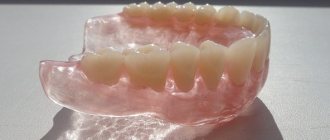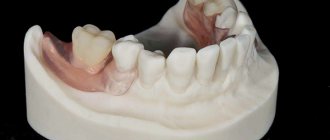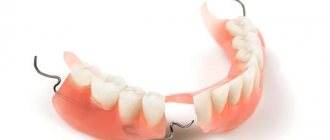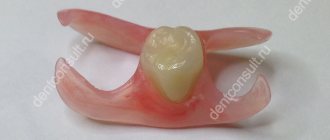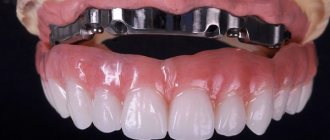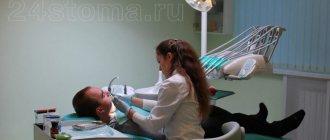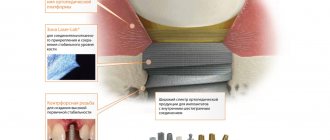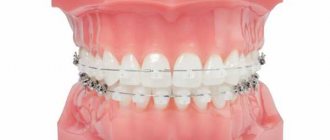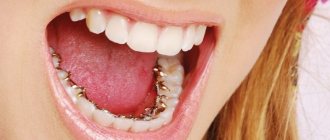21.11.2019
Modern dentistry allows patients not to worry about the loss of one or more teeth. Thanks to modern technologies, you can restore your smile without pain and without consequences. One of the innovations includes removable silicone dentures, reviews of which are mostly positive.
What are these structures?
Silicone dentures – what are they? Let's take a closer look, since there is still a lot of controversy surrounding these products. In fact, there is no such thing as a “silicone prosthesis.” But patients continue to call any flexible or elastic prosthetic structures this way. Because in the common understanding, silicone is something soft, unbreakable, quite elastic and even transparent.
And in dentistry there are materials that correspond to these characteristics. They are used for prosthetics, or more precisely, to imitate mucous membranes and for fastening elements (clasp hooks) to remaining teeth. There are no metal inclusions in the form of hooks or bases here. Suction cup dentures are attached to completely edentulous gums. Below we will definitely consider all flexible materials that have properties similar to silicone.
DENTAL PROSTHESIS ON 6 IMPLANTS - 290,000 rub.
The price includes all manipulations for installing Osstem implants (South Korea), manufacturing, installing and fitting the prosthesis, including anesthesia and diagnostics.
Save RUB 30,000. >> Call now or request a call
Opening hours: 24 hours a day - seven days a week
Dentists prefer to call dentures with “silicone” properties not soft, but flexible. Because such structures do not wrinkle, but only bend a little. Moreover, this flexibility manifests itself only at the stages of removal and fixation - this makes the patient more comfortable than with rigid acrylic dentures. But an already installed “silicone” prosthesis does not bend to the sides (especially a new one), does not move and fits the dentition quite tightly.
Manufacturing
Making a partial silicone denture
To make a quality product, you must carry out the following steps:
- Preparatory activities. The dentition on which silicone restoration will be performed is thoroughly cleaned of various deposits, and therapeutic procedures are carried out to eliminate caries.
- Take impressions. It is from these that the mock-up of the jaw will be created. An impression tray and plastic mass are used as suitable instruments.
- Make a model of the jaw.
- Make soft silicone devices based on the manufactured model.
Classification of flexible structures
“Silicone”, or rather flexible products, are only removable. They are not made permanent. Let's consider the classification from the point of view of the length of the structure - i.e. how many teeth do they replace:
- single or “butterfly dentures”: replace 1-2 missing teeth, attached to adjacent teeth using clasps,
- partial: replace several missing teeth, incl. in different parts of the row. Attached with hooks to living teeth,
- full: worn with complete edentia, i.e. with complete absence of teeth. They are fixed only to the gums.
Kinds
Prosthetics are carried out using three types of structures:
- A complete denture is placed to restore the upper or lower row when all teeth are missing. But the fixation of the product is insufficient, so the method is used if treatment by other methods is impossible for various reasons.
- A private one is placed to recreate two or three neighboring units. A clasp fastening is used for fixation.
- A single denture is placed to restore one tooth. Fixation is carried out with side clasps to adjacent supports.
Materials and types
As already noted, silicone-based dentures are not used in dentistry. And again, it is worth saying that indeed some materials for prosthetics have related properties - flexibility or elasticity, good colorability in the shade of natural mucous membrane at the manufacturing stage, translucency (if necessary). But still these are different materials. And what the patient himself understands as a “silicone prosthesis”, or some clinics offer under the name “silicone”, is actually one of the following materials:
- classic acrylic: an inexpensive material that was previously considered too hard and uncomfortable. Nowadays, options are used with the addition of diamond chips, so the dentures are lighter and more comfortable, last a long time,
- nylon: the most flexible material with almost perfect aesthetics, but only in the first year of wear. Then it stretches excessively and is not subject to complex repairs. The most popular manufacturer is Perflex Flexinylon,
- polyurethane: these are domestic designs made from materials - “Dentalur” and the more modern “Pentalur”. They are considered analogues of nylon, but are more rigid and not as porous. Can be repaired
- monomer-free acrylic Acry-free (“Acry-free”): does not contain a monomer (methyl methacrylate, which is found in classic acrylic), which can provoke allergies. Less flexible than nylon, but very durable. To be repaired
- Dental D from Quattro Ti (“Quadrotti”): this Italian material is distinguished by high aesthetics and low flexibility. It has one peculiarity - when restoring the upper jaw, instead of a fused artificial palate, a thin bridge is made here, like in clasp ones. Therefore, “Quadrotti” is often called their analogues. Can be repaired for minor defects. Not suitable for completely edentulous patients.
You can read more about each variety - features, characteristics, pros and cons - by following the links.
This is interesting! Specifically, silicone materials can be used to take impressions (molds) before prosthetics.
At the stage of manufacturing a denture, silicone is used as an auxiliary material - to create a model1 of new teeth, for fastening elements, and as silicone keys for veneers.
What do removable silicone dentures look like?
The use of the term “silicone” is not entirely correct. This is usually the name given to products made not only from silicone, but also from acrylic and nylon. The main thing they have in common is increased softness. Most often they are made from the following materials:
- Nylon, which is highly flexible, can independently restore its shape even after strong bending.
- Akri Free are so-called “semi-rigid” prostheses. They are made from special acrylic that does not contain a monomer and are less elastic.
Silicone dentures are those that are made of acrylic or nylon.
In both cases, the design looks approximately the same. Its main parts:
- A base that imitates the shape of the sky and is fixed on it. It is made from nylon or Acree Free.
- Artificial teeth, usually made of metal ceramics.
- Clasps made of the same material as the base. Clasps are necessary for partial dentures or when installing dentures on implants.
Indications and contraindications for the use of such structures
Dentists may suggest installing an elastic prosthetic structure for the following indications:
- absence of teeth (one or more),
- complete edentia,
- allergy to regular acrylic: the monomer contained in acrylic structures can cause irritation and swelling of the gums - especially if the manufacturing technology is not followed,
- when there are contraindications to fixed prosthetics: for example, in patients with decompensated diabetes mellitus, cardiovascular and endocrine pathologies, in children, pensioners, and during pregnancy.
Contraindications are the presence of mobile teeth (the prosthesis will loosen them until they fall out completely), as well as mental pathologies, when the patient may unknowingly swallow an artificial “jaw”. The presence of stomatitis and caries is also considered a contraindication, but a relative one - after treatment you can get prosthetics.
Advantages of elastic prosthetic structures
The following positive qualities are considered to be the advantages of removable flexible structures:
- small weight of the product,
- minimal number of contraindications (can be given even to children),
- hypoallergenic,
- relatively low cost of prosthetics,
- higher level of wearing comfort (compared to conventional acrylic ones).
PROSTHETICS WITH 6 OSSTEM IMPLANTS FROM RUB 200,000.
Complex implantation Osstem (South Korea) with delayed loading after 4-6 months.
Call now or request a call
“I didn’t know what kind of prosthesis to put in after the bridge fell out along with my front teeth. And it lasted only 3 years ((The dentist advised me to make some new clasps, called “Quadrotti”. She said that they are in use now, light and comfortable. Well, or get implants. But I haven’t decided on them yet, but “Quadrotti” "We did it. It’s really comfortable with them, but we’ll see how things go.”
Alena K., review from gidpozubam. ru
Advantages and disadvantages of silicone teeth
Many patients choose silicone prostheses because they have truly worthy qualities:
- Excellent aesthetics, thanks to which the designs are sometimes called “invisible”. The base is made of nylon in different shades and has a certain transparency, so it is possible to choose colors that do not differ from the color of the gums.
- Low weight and volume. This advantage becomes especially noticeable when compared with acrylic ones, which take up a lot of space in the oral cavity. Nylon and Acre Free are durable but lightweight materials, making them much more comfortable to wear.
- Clasps are made from the same material as the base. In clasp designs, they are usually metal, so they are often visible when you smile. Nylon eliminates this drawback: the clasps are translucent and do not grip the supporting teeth, but the gums near them.
- No allergic reactions. The material does not contain a monomer, which causes allergies in patients using acrylic products.
This is what the Akri Free soft prosthesis looks like.
However, despite all the obvious advantages, the use of silicone models is not without drawbacks, quite significant ones that prevent their widespread use:
- Inconvenience when chewing. The reason is the increased flexibility of nylon. It becomes deformed when chewing or biting, and folds form that irritate the mucous membrane.
- Uneven distribution of chewing load: pressure is transferred to the mucous membrane in the place where the base presses, and is not distributed over the entire bed, as when wearing acrylic products.
- Under the artificial jaw, the bone tissue atrophies, this becomes a consequence of increased chewing pressure in this area.
- Nylon is difficult to polish; over time, the surface becomes rough, darkens, and bacteria begin to multiply in the resulting micro-cavities.
- Poor fixation, especially in the case of low crown heights. Food gets under the base and can fall out during a conversation if special fixing agents are not used.
- Under the influence of chewing load, nylon changes visually, becoming darker and less transparent.
Acri-Free is very light, the addiction process is faster
The listed disadvantages apply to nylon products. Acry Free is made from a different material that has increased hardness and combines the advantages of nylon and acrylic. They do not have most of these disadvantages and today are one of the priority options for prosthetics.
What can you say about the cons?
Flexible orthopedic structures have many more disadvantages than advantages. Let's take a closer look at their disadvantages:
- the likelihood of displacement and falling out of the mouth: it is elasticity that leads to the fact that chewing pressure is not very correctly redistributed to the jaw bone, so inconvenience may occur when eating,
- damage to supporting teeth: they are overloaded and fail faster,
- gum injuries from the pressure of clasps,
- discomfort: full dentures with a massive palate can cause nausea, prevent you from tasting food, lead to excessive salivation,
- need for adaptation: getting used to removable ones, even if they are small, quite long - at least 7-10 days,
- the risk of irreversible changes in the properties of the material: excessive stretching of the base as a result of active use (applies mostly to nylon) will lead to the fact that the prosthesis will have to be changed before the declared “shelf life” expires,
- increased adhesion of food to the nylon base: the inner part is rough and, as hygiene deteriorates, it becomes a place for the accumulation of microbes that provoke inflammation.
Production and installation
Models made of flexible materials are manufactured in several stages. First you need to carry out dental treatment, if necessary. These could be events:
- treatment of caries;
- removal of dental plaque;
- whitening;
- filling.
To make a model of the jaw, impressions are taken of the teeth and made using a special plastic mass. In laboratory conditions, they are filled with plaster and wait until it hardens. The result is a model with the outlines of teeth. Then the models themselves are made from flexible material, according to the layout.
Many patients are advised to find out whether other dental prosthetic options are possible before installation. This is due to the fact that wearing structures brings a certain discomfort to many. The product is secured with clasps, they are fixed to the supporting teeth, and if they are missing, then implants need to be implanted, which act as supporting elements.
How structures are made
Before any prosthetics, the patient must undergo preparation - to cure or remove diseased teeth, restore gum health, cure stomatitis. Ideally, do a computed tomography scan of the jaws, which will show the condition of the bone substance and the root system of the remaining teeth. After this, the orthopedic dentist takes impressions or impressions of the dentition and other parameters of the dental system (using an articulator, face bow).
It is impressions, as already mentioned, that can be made using silicone materials. To create and reline removable structures, as a rule, A-silicone is used.
Next, a model of the prosthesis is made from the impressions, which is tried on and modified in accordance with the edits. Materials acquire elastic properties under the influence of high temperatures during the manufacturing stage in a dental laboratory. In addition to the classic manual manufacturing method, modern thermoplastic materials (for example, Perflex Biosense) can be milled using CAD/CAM systems with the highest precision. Once the flexible denture is ready, sanded and polished, it is handed over to the prosthodontist.
Manufacturing technology.
Silicone-based structures are characterized by high biocompatibility and hypoallergenicity. They do not absorb odors and are also highly resistant to pigmentation and staining. The manufacturing process can take from 2 days to a week. Depending on the professionalism of the dentist, the technical equipment of the clinic and the length of the prosthesis, this period may vary. Work on the orthopedic device is carried out in several stages:
Clinical.
The dentist prepares the oral cavity and, if necessary, prescribes sanitation. Upon completion of the treatment procedures, impressions of the jaw are taken and a plaster model is created based on them.
Laboratory.
Based on the resulting model, a silicone base is produced, onto which artificial crowns are attached. The device is tried on by the patient and if it fits, the doctor fixes it on the gums.
Which material is better to choose, alternatives
Often a person cannot decide which prosthesis is better to choose - plastic or silicone (here we mean, of course, flexible). Let's figure it out. Plastic or plastic are popular “middle” names for acrylic prosthetic structures. That is, we will compare rigid and flexible products (although, in fact, almost all of them contain polymers, i.e. plastic). Hard ones are very durable, distribute pressure well, but can rub the mucous membrane2 and provoke its irritation. On the other hand, hard acrylic ones with compact dimensions (without a palate) can be fixed on implants - and this is the most reliable method of tooth restoration today. They can be called the best alternative to flexible removable dentures.
Flexible ones are also quite durable and do not rub your gums at first. But when the bone sag (and it will sag over time to one degree or another for everyone), then the flexible one will become uncomfortable and will rub. It can also stretch, and not all materials can be repaired. Elastic structures are not placed on implants.
REPROSTHETICS WITH ACRYLIC PROSTHETICS - RUB 200,000.
Re-prosthetics with an acrylic bridge on a metal frame (all included) up to 12 units.
Save RUR 30,000. Call now or request a call
Therefore, any removable options are recommended only as a temporary solution (especially nylon, which was created specifically for temporary wearing), or if there are significant contraindications to implantation. Otherwise, the choice depends on the clinical situation and the wishes of the patient - Acry-free or polyurethane for complete adentia, and Quattro Ti is the optimal solution for partial adentia.
Recommendations for care and wearing
How to care for “silicone”, or more precisely, flexible or elastic dentures? Care is not very difficult, but it is quite monotonous. After all, after each meal, even after a small snack, you will have to remove the denture from your mouth and rinse it with clean running water. And also rinse your mouth. The structure must be cleaned using a special brush (available at any pharmacy) and a paste without scratching particles. Once a week you need to soak in a disinfectant solution - it is also sold at any pharmacy in the form of liquid or tablets.
Wearing it in the first days may not be comfortable, because you need to get used to the new “jaw”. Dentists recommend leaving it in your mouth for as long as possible without removing it at night. You can also recite tongue twisters and read aloud. In terms of nutrition, any hard food is a restriction, because... the structure may lose its fixation and fall out, or break under very strong pressure.
Benefits of silicone dentures
- due to their elasticity, they perfectly follow the contours of the sky and fit tightly to the gums, thanks to which the area of the dental bridge can be minimized, but this will not affect the strength of fixation;
- the load on the supporting teeth is minimal, there is no need to grind them; the structure is easily removed;
- during chewing, silicone bridges do not deform and evenly distribute the load over the entire gum, that is, they behave like natural tissues of the oral cavity;
- silicone perfectly matches the natural color of the patient’s mucous membrane, making it completely invisible in the oral cavity;
- unlike plastic ones, nylon dentures are durable, resistant to both mechanical stress and dyes included in food;
- the natural appearance does not change over years of use: with proper care you will not find any scratches, dents, or darkening;
- unlike acrylic, silicone does not cause allergic reactions;
- the material is very soft, so a dental bridge made from it is light and does not put pressure on bone tissue, which allows the use of this type of prosthetics for periodontal diseases.
Thus, wearing these dental bridges is comfortable for the patient: adaptation is easy and quick, the sensations are as close to natural as possible.
How much does it cost to restore teeth?
How much do elastic removable dentures cost? The price depends on the material - its quantity and characteristics, on the manufacturing features. The cost of prosthetics may increase due to the use of silicone materials for taking impressions. For example, silicone mixtures (A-silicone in particular) are an order of magnitude more expensive than alginate ones. If we look at prices for flexible structures specifically by product type, then an “immediate butterfly” made of nylon costs from 20 thousand rubles, Acry-free – also from 20 thousand, Quattro Ti – from 32 thousand, and polyurethane – from 35 thousand rubles.
1Haug S., Correct modeling, 2006. 2Galonsky V.G., Radkevich A.A. Reaction of the mucous membrane of the supporting tissues of the prosthetic bed to the influence of removable dentures, 2009.
Author: Chernov A. R. (Thank you for your help in writing the article and the information provided)
